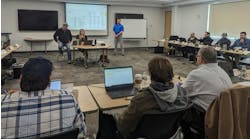For the last few months I’ve been writing a primer of sorts on becoming a project manager. Previous columns covered determining if you have the aptitude to be a project manager; the education and credentials required; and assessing potential employers. This month I’d like to provide an overview of the project management process.
The project management process consists of four main components:
- Creation of a project management map;
- Supplying the job with resources;
- Allocation and use of those resources during the job’s execution; and
- Demobilizing at the job’s end.
Before you can begin a project management journey, you must have a process map. All management protocol models use maps of one kind or the other, for things as mundane as buying office supplies or as complex as quarterly revenue forecasting. Project management is no different.
This project management map can be an informal mental map in your head, a simple written map such as a Gantt chart or a more complex resource map such as a CPM chart. A PM map needs to have enough detail to show how to get there, but not so much detail as to become confusing.
The base of the project management map begins with the project definition. The ability to define something creates an environment to give birth to it. What’s the difference between these two project definitions?
- “ABC Building, plumbing & heating contract, new construction, your town, your state” and
- “ABC Building, plumbing & heating contract, new construction, site location is their town approximately 25 miles from main office, contract time 270 calendar days, liquidated damages $1,000 per day, contract price $3 million, target gross margin 28%, target net income 10%”?
Offhand, I’d say the potential difference between the two definitions is about $300,000.
The second step in the mapping process is the “hand off,” where all the raw data, such as the initial time-and-material estimate and general conditions estimate is handed over to the project manager. At this point, he has to plan his route and get a sense of the obstacles in his way.
The third step is putting the map on paper. I can’t emphasize how important it is to put something down on paper, no matter how small the job. If you’re going to manage a project, write even the briefest of plans on how you intend to accomplish it. Without this map, you won’t get to your destination, or you’ll get there having squandered your job profits or credibility.
For medium jobs you’ll need to do a Gantt chart and larger ones will need a full-blown CPM chart, but even small jobs will need a descriptive title and an elaboration after it on how you intend to manage the project.
Now let’s move on to allocation of resources. You need to supply the job with human resources, equipment and capital. More than likely, the provisioning will be tightly governed by company policy and scrutinized by management. Any potential problems the project manager foresees because of inadequate resources for the job need to be stated in writing to upper management and then discussed in person with them. Keep written minutes of that meeting for future reference by all parties.
The project manager has to apply those resources carefully during the life of the project. Keep complete, detailed accounting of all uses of all resources by such means as job-coded invoices, job specific payroll records, job progress photographs and daily hand-written entries by the project manager into his personal PM Journal.
The last step in the project management process is the job closeout and demobilization phase. Make sure all contractual obligations are completely fulfilled to the owner, general, your subs and vendors. Make sure all necessary releases are signed. Make sure all job correspondence is filed in the correct job folders for ease of future reference. Box and label any physical samples taken as evidence of contract compliance and store them in a secure place.
Put written documentation of the location of the samples in the job folder. Make sure the accounting department is aware of the actual date of project completion within one week, so that they can begin doing their own specific job closeout procedures.
I could write entire columns on any aspect of the project management process, but this column was intended as a general overview only. Any feedback, negative or positive, is most welcomed.
H. Kent Craig is a second-generation mechanical contractor and project manager with unlimited master’s licenses in boilers, air conditioning, heating and plumbing. He may be reached by calling 919/851-3985, or via e-mail at [email protected].

